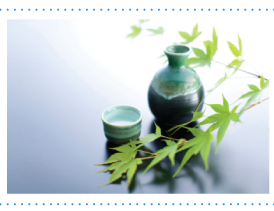|

...continued from the previous page
TYPES OF SAKE
HONJOZO
These are Sakes to which a small amount of distilled alcohol has been added. This is the most common type of Sake, but don’t be fooled into thinking that Honjozos are all of lower quality. While  it’s true that most poor Sakes are made this way, the simple addition of alcohol can often bring out wonderful aromas and flavors. Some of the worst Sakes are Honjozos, but so are some of the very best values. Generally lighter, and frequently very fragrant. it’s true that most poor Sakes are made this way, the simple addition of alcohol can often bring out wonderful aromas and flavors. Some of the worst Sakes are Honjozos, but so are some of the very best values. Generally lighter, and frequently very fragrant.
JUNMAI
These are pure Sakes, nothing but rice, water, yeast, and the Koji mold that makes everything possible. Generally heavier and with more mouth weight than Honjozo, any Ginjo and Daiginjo Sakes are Junmai.
GINJO
Ginjo Sakes are sakes that use rice with at least 40% of the kernel ground away before the brewing process begins. This removes much of the starchy outer shell, which adds little to the clarity and brightness of the Sake and can interfere with the purity of the finished product.. Obviousy this is very costly, is done in a very limited number of Sakes, and currently represents about 6% of all Sakes in the market.
DAIGINJO
This level goes even further, with at least a full half of the rice kernel ground away. Very few Sakes carry this designation, and they are worth seeking out. Ginjo and Daiginjo Sakes are the apex of Sake making. These are generally light, delicate and beautiful, with intricate flavors and great balance.


Content contributed by Anne Drummond, Imperial Beverage
As a server or bartender, proper wine service is a skill you’ll not do well without. From order to presentation and follow up, there are particular steps that are important in the formal service of wine.
First, all bottled wines should be presented using these steps, regardless of the cost or perceived wine knowledge of the guest in your establishment. All bottled wines being delivered to the table should be treated with the respect due the wine maker, establishment, and of course, the person ordering the selection.
TAKING THE ORDER
While you may not know every detail or idiosyncrasy of a particular wine, it is important that you have a general understanding of the categories on your establishment’s list. Even if you are not a wine drinker or haven’t tasted much of the list, have a working knowledge of the categories of wines on the list, and have a “favorite” in each. This favorite should be something that is proven and well-received at the location, and should be in the mid-range price level. Any guest can see through a server that recommends only the most expensive bottle in the category. Additionally, have a by-the-glass or bottle recommendation ready when a guest orders a signature dish. Appearing knowledgeable is key.
When a glass or bottle of wine is ordered, repeat the order back to the guest. Be clear and succinct. Be sure that you understand the varietal, brand, and vintage desired.
PRESENTING THE BOTTLE
Assuming that appropriate, polished glassware is already at the table, approach the host with the bottle of wine he or she ordered. Treat the bottle gently, as though it were special and delicate. Tip the bottle’s top back, toward your body, with the body of the bottle cradled in your arm, label side facing the host. “Present” the bottle to him or her by standing at his or her right side and restate the name of the wine including the varietal, brand, and vintage. (All beverage service occurs from the right of the guest, with your right hand, unlike food service, which is from the left with the left hand). The host will nod or gesture that the wine is what was expected. This is your cue to begin opening.
OPENING THE BOTTLE
Keeping the label facing the host as much as possible, take out your arm or service linen and place over your minor arm, holding the bottle in that same hand. With your other hand, use the wine tool to cut away the foil from the top of the bottle. The foil should be placed in your pocket or apron, not on the table. Once cut away, use your service linen to wipe the mouth of the bottle, removing any dust and debris, and generally cleaning the mouth of the bottle before the cork is removed.
Using your wine key, remover the cork from the bottle. Remember, it is not about strength, but rather leverage that allows the cork’s removal. If you have difficulty tableside, practice on by the glass poured wine bottles at the bar, the next shift you work. The bartender will surely allow you to help, offering additional practice.
Once the cork is removed, it is placed to the right of the host’s place setting. He or she may choose to smell, keep, or leave the cork altogether.

|
